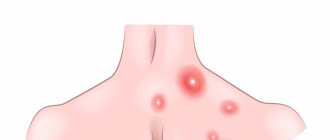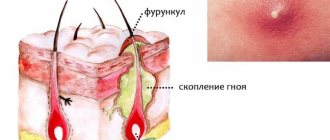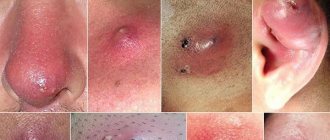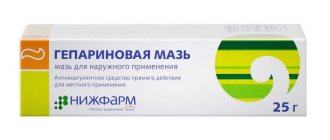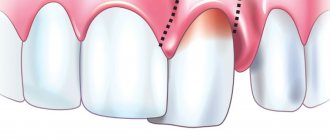The inflammatory process on the skin, especially on the face, is a great stress for the body. Various pimples and pustules bring a lot of inconvenience to a person. But their reasons can be completely different. Some are less dangerous, others can lead to serious consequences. Accordingly, they all require a different treatment approach. Let's look at how to distinguish a boil from a pimple by location, appearance, pain, ripening time and other manifestations, and try to understand the reasons for their appearance.
Factors of occurrence
The causative agent of the infection is usually a pyogenic bacterium - Staphylococcus aureus. This bacterium is present on the skin of any healthy person, and causes infection only if it reaches the deep layer of the skin (for example, through microtrauma). The development of boils is also promoted by:
- dirty skin;
- increased sweating;
- overweight;
- poor nutrition;
- hot humid climate;
- hormonal imbalances in the body;
- poor metabolism.
People with diabetes mellitus, skin diseases, and those prone to stress and depression are often at risk of developing furunculosis because they have a weakened immune system.
How to distinguish a pimple from a boil
With the onset of skin inflammation, it is important to recognize the difference between an abscess, blackhead, boil and pimple in order to take the correct treatment measures. The approach used in one case will not be applicable in another.
Appearance
The first sign that makes it possible to distinguish a boil, as a boil is popularly called, from an inflamed pimple is its appearance.
Pimples, also called acne, are small, round, pink to burgundy-red inflammation of the hair follicle.
At the beginning of the formation of a boil, the skin thickens and a tubercle forms, which indicates damage to the deep layers of the epithelium. As the boil matures, it turns red, without clear external boundaries. Redness indicates the presence of an inflammatory process.
Simultaneous infection of several hair follicles is called a carbuncle.
A purulent-inflammatory disease may be accompanied by an increase in nearby lymph nodes.
Reasons for appearance
A significant difference between a pimple and a boil is the reason for their appearance.
Acne can form as a result of hormonal activity, heredity, diseases of the digestive organs, due to stress, hypothermia, and excessive amounts of cosmetics. Under the influence of unfavorable factors, the secretion of the sebaceous glands increases. Deterioration in the outflow of the resulting secretion leads to blockage of the hair follicle with sebaceous-horn plugs, which ends in an inflammatory process.
In the case of boils, the main cause of their formation is Staphylococcus aureus. Trauma to the superficial and deep layers of the skin, for example, during shaving in men, impaired metabolism, decreased immunity due to poor nutrition or other diseases, increase the likelihood that the protective mechanism will not work, and the infection can enter the hair follicle. When bacteria penetrate the follicle, purulent inflammation is formed not only of the follicle itself, but also of the surrounding connective tissue.
Frequent localization
The most common places for boil formation are the face, back of the neck, back, thighs on the outside and inside.
Unlike a boil, acne can form anywhere on the surface of the skin, but most often they appear on the face, upper chest and back - the locations of the largest number of sebaceous glands.
Ripening time
A boil differs from a pimple in its ripening time. The pimple is characterized by a slight inflammatory process that ends on the third or fourth day.
For the first few days, the boil may not even be noticeable. The only thing that attracts attention at this time is the painful thickening of the skin. Over time, it grows, turning into a tubercle. As the inflammatory process continues, the skin around the tubercle turns red and the shaft becomes visible. The last stage of development of the boil - the breakthrough of the contents outwards - is completed by the tenth to fourteenth day.
Pain
A boil is distinguished from a pimple by pain, which helps to understand the nature of the inflammatory process.
Pimples do not cause any pain at all, unless they are picked off or mechanically damaged in some way.
The boil hurts from the very beginning. Even before redness appears, pressing on the resulting lump causes pain. This feeling intensifies as the boil matures and goes away only after the purulent contents are released.
Along with pain, inflammation with a boil causes a local increase in temperature. With multiple rashes, the temperature of the whole body rises.
How and how long are skin lesions treated?
The appearance and treatment of pimple is determined by its etiology. Since acne is formed as a result of increased secretion of the sebaceous glands, treatment will be aimed at eliminating this condition. This is a long process that requires hormonal regulation. In addition, folk remedies are used to raise the overall level of immunity.
To get rid of a boil, first of all treat its surface with an antiseptic to prevent the spread of infection. Special ointments or other means are applied to the boil stem to promote its rapid maturation and the release of purulent contents. After the boil breaks out, they continue to take the necessary measures to prevent re-infection of the open wound until it heals. In severe cases, the doctor may prescribe antibiotics.
The appearance of acne or boils indicates a malfunction of the immune system or an infectious infection. Such manifestations should not be ignored. A difficult situation requires mandatory consultation with a specialist.
Stages of development
At the very beginning of development, a boil can easily be confused with an ordinary pimple. However, within 3-4 days the inflammation grows, covering the surrounding tissues. Upon palpation, you can feel the tension and density of these tissues.
After a few more days, a sac with a purulent formation forms in the center of the boil, a necrotic core appears and the tissue softens.
Over time, the boil, unable to withstand a large amount of pus, opens and the pus, rejecting the necrotic core, flows out. After which the swelling gradually subsides and redness passes, and a small scar forms in the center of the former boil.
The most dangerous boils are those that arise near the lips, ears and nose. You should not try to squeeze out boils yourself, even if they have arisen in other locations. This can lead to the spread of infection, which will entail serious complications leading to the development of regional lymphadenitis, lymphangitis, and thrombophlebitis.
What does a ripe boil look like?
A purulent boil matures for 10 days. Before the breakthrough, a necrotic core will be formed inside. The area of the infection is swollen and red. The boil matures and rises above the surface of the skin. At the top of the cone, a white cone-shaped head becomes visible - a protruding rod with a cover made of a thin layer of epidermis. The skin becomes smooth and shiny due to tension.
Locally, an increase in temperature, itching, pulsation, and sharp pain on palpation will be felt. When a feeling of fullness and itching appears, the boil is ripe and ready to burst.
You can understand that the boil is going away by reducing the symptoms and the formation of a scar at the site of the boil.
Treatment at home
If the immune system is functioning well, the boil will heal itself in 7-8 days. But to make the process go faster, you can treat boils at home:
- at the initial stage of development, it is necessary to lubricate the abscess with a solution of fucorcin or brilliant green;
- at the stage of compaction and swelling of the connective tissue, it is good to sunbathe in the sun;
- To make the boil empty faster, you need to apply ichthyol ointment;
- It is better to treat an opened abscess with hydrogen peroxide, and also apply bandages with sodium chloride or honey;
- When the boil begins to heal, it is recommended to apply bandages using Vishnevsky ointment.
To prevent the development of purulent formations, you need to shower daily. Do not scratch the itchy area on the skin. Among other things, it is recommended to wear clothes made from natural fabric.
Time of maturation of boils of different locations
A boil is characterized by development in stages and specific symptoms. The size can reach about 2-3 cm in diameter. The danger to humans depends on the location of the infection and the extent of the inflammatory process. Staphylococcus aureus reproduces well in warm and humid environments. The pathogenic properties of the bacterium are due to the ability in the process of life to form toxic substances and enzymes that cause purulent inflammation in the thickness of the epidermis.
Favorable conditions for staphylococcus are created due to insufficient hygiene of the skin, damage to the integrity of the skin, and weakened immunity.
Frequent places of occurrence:
- on the face, boils ripen in the area of the nasolabial triangle (nose wings, upper lip, chin, eyelids);
- auricle, neck, shoulders, armpits;
- lumbar region, groin, genitals, butt;
- limbs, back of fingers.
The time of boil ripening depends on the location. In places with a low content of subcutaneous fat (the wings of the nose, ears, hands), the boil develops more slowly, the inflammation is localized to a small focus, and is painful. The area does not spread, complications do not develop. Self-healing is possible at the first stage and a necrotic core does not form. When the boil begins to mature, the body suppresses inflammation. Special cells of the immune system quickly destroy bacteria - phagocytosis occurs.
In the area of the inner thighs, forearm, and buttocks, the boil develops with more pronounced clinical symptoms; the infection is accompanied by a deterioration in health and an increase in body temperature. Such inflammation can be complicated by the spread of infection - furunculosis, abscess and carbuncle.
A boil on the face matures quickly; the anatomical feature of this area of the body is the presence of a large number of blood vessels and nerves, which contributes to rapid metabolism in tissues and the creation of favorable conditions for staphylococcus. The nasolabial triangle is a dangerous location due to possible complications: purulent thrombophlebitis (blockage) of the facial veins, which can lead to the development of meningitis.
The entry of bacteria into the blood provokes sepsis, septicopyemia. You need to watch how the boil matures, do not miss the initial manifestations of complications, consult a doctor or call an ambulance.
Body temperature rises to critical levels, unbearable pain, swelling. Dense threads of the angular, facial, and orbital veins can be felt on the face. In the hospital, blood leukocytosis and accelerated ESR are additionally determined, and bacteriological studies are carried out.
A boil of any location takes approximately the same time to mature. Provoking and contributing factors are:
- Hot weather, causing profuse sweating, lack of personal hygiene. The formation of a boil during outdoor sports is typical.
- Changing the pH of the skin to the alkaline side, due to excessive use of aggressive skin cleansers or internal diseases.
- The presence of entry points for bacteria is various damaged areas of the skin: abrasions, cuts, wounds during depilation and shaving, scratching, chafing tight clothing, burns.
- A diet with an excess of fast carbohydrates (sweets), transgenic fats (chips, fast food). Such food changes the composition of sebum and reduces the barrier function of the epidermis.
- Hypothermia of the body, decreased functioning of the immune system (recent illnesses, operations), lack of vitamins (hypovitaminosis). Characteristic of a ripening boil.
- The presence of chronic foci of coccal infection in the body (chronic tonsillitis, sinusitis).
- Hyperhidrosis is a disease characterized by excessive secretion of sweat glands and increased sweating. General systemic diseases of the body leading to hormonal imbalance (thyroid problems, diabetes).
- Physiological changes in adolescence, the menstrual cycle, pregnancy, menopause are characteristic of a boil.
- Sedentary lifestyle, obesity, bad habits. Itchy skin diseases (psoriasis, allergies, dermatosis).
- Acquired antibiotic resistance by Staphylococcus aureus after irrational antibiotic therapy, non-compliance with dosages and timing of use of antimicrobial drugs.
When a mature boil is localized to the face, the course of the disease becomes complicated in 15% of cases. The condition requires hospitalization and intravenous antibiotics. Treat multiple boils under the supervision of specialists. To avoid complications, you need to follow preventive measures and consult a doctor for help in a timely manner. In medical practice, there are cases of death due to complications of a facial boil.
When to contact a surgeon
Boils can be treated at home only for those who are not at risk (do not suffer from chronic diseases), and boils are small in size (up to 5 mm). You should not self-medicate in the following cases:
- if the appearance of a formation is accompanied by intense pain and fever;
- if the abscess has not opened within 2 weeks;
- if furunculosis has developed;
- if the abscess occurs in a small child;
- if the boil is near the nose, lips, in the ear canal;
- there was a relapse of the disease.
Symptoms of the formation of a boil (boil)
There is a slight itching and tingling sensation. On the 1st-2nd day, discharge appears. They protrude in a cone shape over the skin, which becomes red and painful when touched. At the top there is a small accumulation of pus with a black dot in the center.
The abscess usually breaks through and dries out, and on days 3-7, it is excreted with pus in the form of a rod along with the remaining hair. The resulting wound is cleaned, filled with granulation tissue and heals. The swelling around it gradually decreases, the pain disappears. A small, whitish, somewhat retracted scar remains at the site of inflammation.
Multiple lesions with boils that appear simultaneously or sequentially one after another in different parts of the body are called furunculosis. When it lasts with small remissions for several years, it is chronic, recurrent.
In places devoid of hair (palms and palmar surface of fingers, soles) boils do not develop. Most often observed on areas of the skin exposed to contamination (forearms, back of the hand) and friction (back of the neck, lower back, gluteal region, thighs). Typically, a boil does not cause significant health problems. The pain is moderate, but when localized, for example, in the external auditory canal or in the nose, it is significant. In the facial area (lips, forehead), as well as on the scrotum, boils are accompanied by significant swelling of the surrounding tissues, which is explained by the looseness of the subcutaneous tissue.
Antibiotic treatment
In cases where the boil is large or located in sensitive areas, and its development is accompanied by intoxication, chills and severe inflammation, the surgeon prescribes antibiotics.
For a large boil and a slight increase in temperature, a weekly course is prescribed: the doctor prescribes clindamycin or doxycycline.
At high temperatures and severe inflammation, a two-week course of treatment is most often prescribed, which includes stronger antibiotic drugs: rifadin, rimactan or other analogues.
Don’t forget, Staphylococcus aureus easily adapts to a variety of antibacterial agents, and as soon as the body’s defenses are slightly reduced, they multiply and form new abscesses. Therefore, people with reduced immunity should immediately consult a doctor and not self-prescribe medications. Keep in mind that if you relapse, they will no longer help you!
This article is for informational purposes only, please consult your doctor for details!
